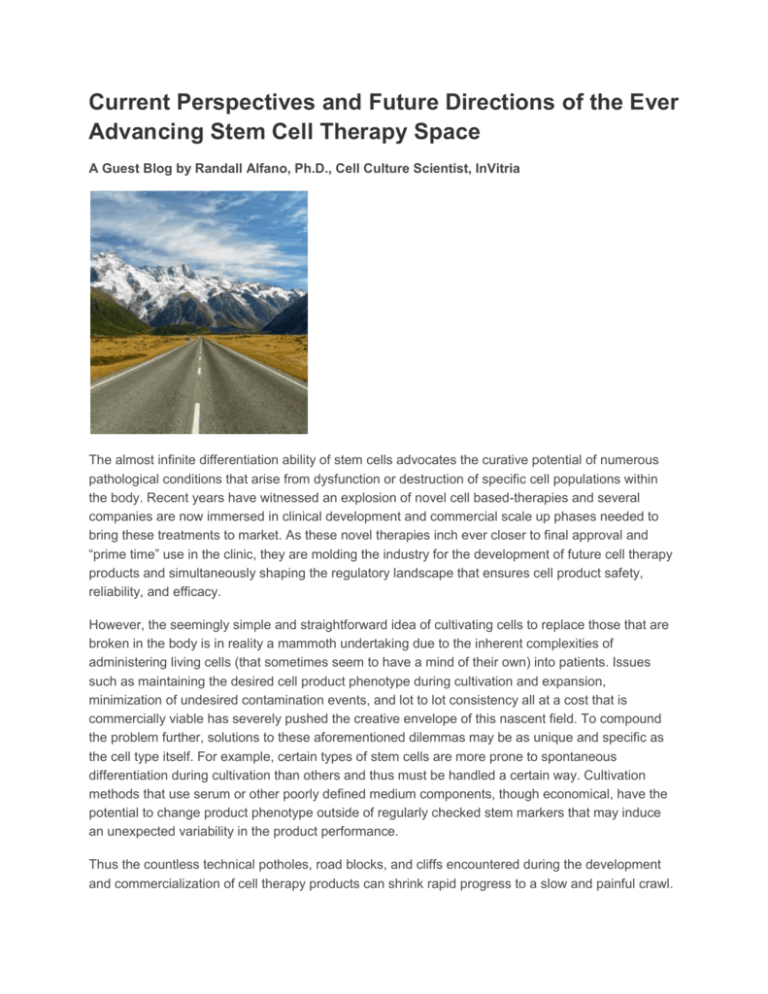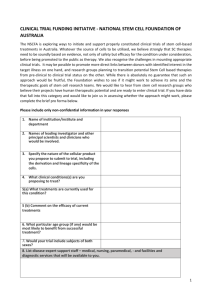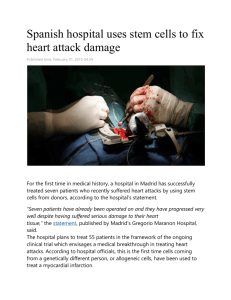Current Perspectives and Future Directions of the Ever
advertisement

Current Perspectives and Future Directions of the Ever Advancing Stem Cell Therapy Space A Guest Blog by Randall Alfano, Ph.D., Cell Culture Scientist, InVitria The almost infinite differentiation ability of stem cells advocates the curative potential of numerous pathological conditions that arise from dysfunction or destruction of specific cell populations within the body. Recent years have witnessed an explosion of novel cell based-therapies and several companies are now immersed in clinical development and commercial scale up phases needed to bring these treatments to market. As these novel therapies inch ever closer to final approval and “prime time” use in the clinic, they are molding the industry for the development of future cell therapy products and simultaneously shaping the regulatory landscape that ensures cell product safety, reliability, and efficacy. However, the seemingly simple and straightforward idea of cultivating cells to replace those that are broken in the body is in reality a mammoth undertaking due to the inherent complexities of administering living cells (that sometimes seem to have a mind of their own) into patients. Issues such as maintaining the desired cell product phenotype during cultivation and expansion, minimization of undesired contamination events, and lot to lot consistency all at a cost that is commercially viable has severely pushed the creative envelope of this nascent field. To compound the problem further, solutions to these aforementioned dilemmas may be as unique and specific as the cell type itself. For example, certain types of stem cells are more prone to spontaneous differentiation during cultivation than others and thus must be handled a certain way. Cultivation methods that use serum or other poorly defined medium components, though economical, have the potential to change product phenotype outside of regularly checked stem markers that may induce an unexpected variability in the product performance. Thus the countless technical potholes, road blocks, and cliffs encountered during the development and commercialization of cell therapy products can shrink rapid progress to a slow and painful crawl. This ugly reality has reduced many scientists, clinicians, and investors to the likes of whining 5 year olds asking their mothers “are we there yet?” Minus the whining, the question posed is an important one. Are we well on our way to realizing the true potential of stem cells and stem cell therapy or does it seem that we are finding ourselves down a certain creek without the proverbial paddle? In 2015, our aim is to provide a deeper understanding of the cell therapy space by first outlining the major therapeutic cell types currently in commercial development as well as cells that are deeper in the clinical pipeline. We will then highlight popular methods of cell cultivation and processing and then conclude our series with manufacturing trends of the industry. Once complete, we hope to not only create a clearer picture of the industry for our readers, but to ensure all those whiny 5 year olds that we are in fact in an all-out sprint to the cell therapy promised land. Major Therapeutic Cell Types Fibroblasts This seeming simple cell type represents a major workhorse in the cell therapy space. Fibroblasts can be used directly as the therapeutic cell or can be reprogrammed into induced pluripotent stem cells (iPSCs) for the subsequent generation of other desired somatic cell types. Applications that utilize either autologous or allogeneic fibroblasts directly include treatments for rare skin and connective tissue diseases, burn grafting, and wound healing. Some notable fibroblast-containing therapies that have received approval by the FDA include Advanced Biohealing’s Dermagraft, an allogeneic fibroblast on an extracellular matrix for diabetic foot ulcers (2001). Though approved as a medical device, more recent approvals such as Fibrocell’s LAVIV, an autologous fibroblast for moderate to severe nasolabial fold wrinkles in adults (2011) and Organogenesis’ GINTUIT, an allogeneic keratinocyte and fibroblast mixture on bovine collagen for topical treatment mucogingival surgical wounds (2012), have been approved as cellular therapy products. Reprogramming of fibroblasts to iPSCs and eventual differentiation of target somatic cell types represents the holy grail of cell therapy. A vast array of devastating incurable conditions from amyotrophic lateral sclerosis (ALS) to heart failure are now squarely in the sights of investigators thanks to somatic cell reprogramming. The number of newly found applications of iPSCs doesn’t seem to be slowing down either. Positive efficacy data of iPSCs in animal models in a vast array of diseases are only adding to the excitement of the curative potential of iPSCs. However, laboratory-based methods of iPSC generation/expansion and subsequent differentiation into the desired cellular phenotype is time consuming, costly, and can produce somewhat variable results in terms of differentiation efficiency, cell viability, etc. Extensive process development is typically required to ensure scalability and robustness of the cell manufacturing process while minimizing variability. Regardless, significant progress has been made as evidenced by the first clinical trial regarding the safety and feasibility of iPSCs being approved in 2014 for the treatment of age-related macular degeneration in Japan. More iPSC-based trials will surely follow suit in the near future. Adoptive T Cell Therapy Immunotherapies are becoming an extremely potent weapon in the oncologist’s arsenal. The concept is simple. Extract a cancer patient’s T cells and reprogram them to elicit a cytotoxic response against cancer cells that express a specific antigen. Reprogramming of T cells against tumor-specific antigens is typically done by introducing DNA into isolated T cells that encodes either the native alpha and beta chains of a T cell receptor (TCR) specific for a tumor antigen or single-chain variable fragment (extracellular domain) of a tumor specific antibody that is fused to an intracellular signaling domain. Subsequent developments have included the addition of one or multiple costimulatory domains for enhanced in vivo T cell persistence and expansion. These genetically engineered receptor-expressing cells have been dubbed “chimeric antigen receptor”, or CAR-T cells. These newly redirected CAR-T cells are then expanded to a clinically relevant number and readministered back into the patient. Multiple redirected T cell clinical trials have been performed in an array of tumors including AML (Lewis Y), Colorectal (CEA, Her-2, TAG-72), Breast (CEA), leukemia and lymphoma (CD19), melanoma (gp100, MART-1), neuroblastoma (GD2), Ovarian (aFR), and prostate cancers (PSMA) with some trials demonstrating either partial responses or stabilization of disease. The most promising of these redirected T cell therapies appears to be the CD19 CAR T for B cell malignancies. Clinical studies with these CAR T cells have shown to induce complete or partial remissions of the disease in the majority of patients treated. However, redirecting the wrath of the immune system does not come without certain consequences. Either “off target” (cross-reactivity of normal cell surface antigens with the targeted TCR) or “on target” (normal cells that express low levels of the target antigen) T cell-mediated toxicity can induce serious side effects that can include multiple organ failure and death. Recent efforts to reduce the risks associated with T cell therapies have been focused on the introduction of an inducible cell suicide genes along with the transgenic T cell receptor. This “kill switch” would allow a clinician to shut off the administered T cells if toxicities were observed and thus prevent or mitigate the clinical complications observed. Regardless, the field of adoptive T cell therapy is blossoming and will continue to make significant strides in the development and commercialization of T cell-based therapies. Mesenchymal Stem Cells Mesenchymal stem cells, or mesenchymal stromal cells (MSC), are a cumulative group of multipotent stem cells that have received considerable attention since their discovery in the 1950’s due to their easy accessibility and presence in most adult tissues. Given that their natural role, at least in part, is thought to be tissue repair and wound healing, MSC-centered therapies are currently being developed for an array of conditions including orthopedic and neural injuries, graft versus host disease, and various autoimmune disorders. However, despite the well-observed benefits of MSC administration in both in vitro and in vivosystems, the mechanism of therapeutic efficacy of MSCs is still not fully understood. MSCs, with the correct environmental cues, exhibit potent anti-inflammatory effects via the suppression of both innate and adaptive immune cell function and possess the ability to specifically migrate to sites of inflammation. Further, MSC-derived paracrine factors can polarize the promotion of anti-inflammatory T regulatory cells over pro inflammatory effector T cells. Thus, the current consensus is that MSCs have a multimodal route to produce the observed benefits. As a result, MSCs and more primitive types of MSC have been extensively studied in animal models of human disease and have progressed to clinical testing in an array of human conditions. Some notable trials and success include the allogeneic mesenchymal precursor cell MPC-06-ID (Mesoblast) for chronic low back pain due to degenerative disc disease. Positive Phase II 12-month results were reported as well as the launch of a phase III trial in February, 2015. In addition, the allogeneic MSC product MSC-100-IV was reported to significantly improve survival of children with severe steroid-resistant graft versus host disease. Prochymal, an allogenic bone marrow-derived MSC developed by Osiris Therapeutics, which was acquired by Mesoblast in 2013, is now under evaluation for GVHD and Crohn’s Disease. Other notable companies in the MSC space include Cytori, Bioheart, Stemedica, Brain Storm Cell Therapeutics, and Tissue Regeneration Therapeutics Inc. Hematopoietic Stem Cells Bone marrow transplant for malignant or benign hematological conditions currently represents the only widely practiced stem cell therapy in the clinic. Hematopoietic stem cells, originally derived from the mesoderm, represent a multipotent population of cells that give rise to all other cell types found in the blood and immune system. Classically, CD133 and CD34 are 2 cell surface markers used for enrichment and identification of HSCs. CD133-expressing cells are typically more primitive than CD34+ cells, which are considered to be more skewed toward endothelial differentiation. None the less, both of these subtypes of HSCs have shown efficacy in humans. Intracoronary administration of CD133+ cells promoted recovery after myocardial infarction while CD34-expressing cells were found to hint at improving coronary artery disease. Some notable cell products in late-stage development and clinical testing include Baxter’s adult autologous cell therapy product for chronic myocardial ischemia. A CD34+ HSC dubbed “Renew”, Baxter initiated a Phase III trial in the beginning of 2012 and results are expected in mid-2016. GlaxoSmithKline has been developing an engineered HSC-based therapy for the treatment of adenosine deaminase (AD)-mediated severe combined immunodeficiency syndrome. Known as GSK2696273, HSCs are retrovirally transduced to express the AD gene and re administered back to the patient. StemEx, an umbilical cord blood-derived HSC graft from Gamida Cell-Teva Pharmaceutical Joint Venture, is currently in Phase III multicenter trial for patients with hematologic malignancies who fail to find a matched bone marrow donor. Neural stem cells Neural stem cells (NSCs) are multipotent stem cells typically found in the subventricular and subgranular zones of the brain. These cells possess the ability to differentiate into cells of the peripheral and central nervous systems. NSCs have demonstrated significant ability to improve or reverse symptoms in multiple animal models such as ischemic stroke, spinal cord injuries, Parkinson’s disease, ALS, and Alzheimer’s disease. A few notable clinical trials utilizing neural stem cells include CTX0E03 DP, an allogeneic neural stem cell from Reneuron Limited. These cells are delivered intracranially to the area of the brain that was damaged by ischemic stroke. Results from this pilot study are expected March 2015. Neuralstem is developing a spinal cord-derived neural stem cell line for multiple indications including ALS (Phase IIa), spinal cord injury (Phase I) and ischemic stroke. The City of Hope Medical center is conducting a Phase I trial of neural stem cells, dubbed HB1.F3.CD, that have been genetically modified to express cytosine deaminase, an enzyme required convert flucytosine to 5-fluorouracil for use against glioblastoma. Concluding Remarks The categories and trials described above is by no means a comprehensive description of active clinical cell therapy R&D. Multiple laboratories, hospitals, and biotechnology companies are fervently working on other cell types for therapeutic indications that are not mentioned here. Viacyte has developed the PEC-01 pancreatic endoderm cell product that are differentiated from embryonic stem cells. These insulin-secreting beta cells are encapsulated in a proprietary capsule that is implanted under the skin of diabetes patients. Argos Therapeutics harvests dendritic cells (DCs) and uses a tumor sample from the patient to activate the DCs prior to re administration. Thus, what this brief review proves that there is certainly no shortage of ideas and approaches as to how to address unmet clinical needs in the treatment of devastating diseases and injuries and at the same time push the cell therapy space continuously forward. Don’t miss our following pieces on cell culture methods and media in stem cell therapies where we will describe some of the current trends in industry.







